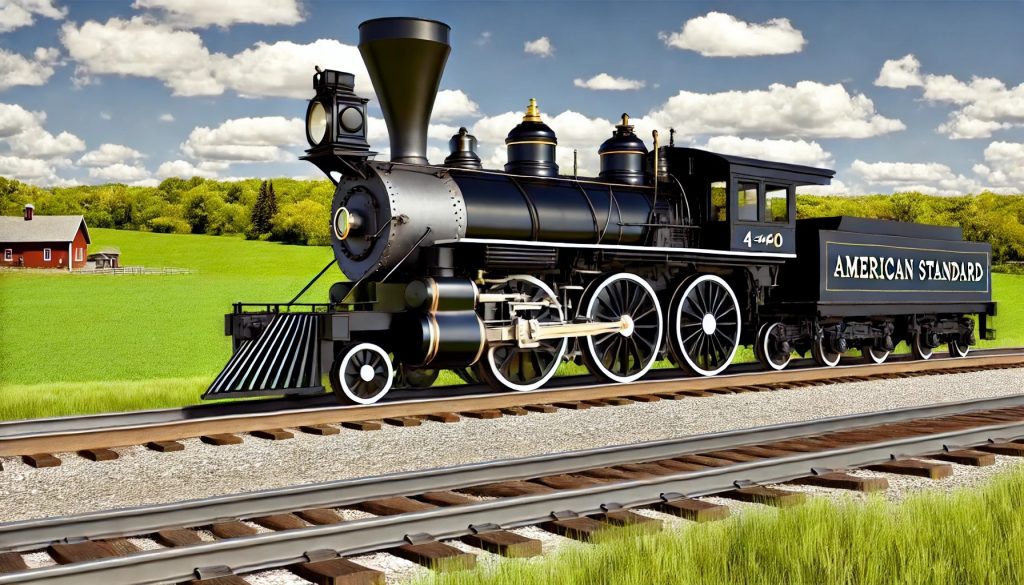The clattering thunder of an iron horse barreling down the tracks is a quintessential image of American progress. But nobody alive remembers the sputtering, rickety contraptions that first coughed their way onto the scene in the early 1830s. It was through the ingenuity and tireless experimentation of American engineers that these early “novelty” locomotives evolved into the powerful and efficient workhorses known as the “American Standard.” This essay delves into the intricate story of their development, highlighting the key innovations and the companies that drove them.

I asked Chat GPT to create a photo-realistic image of an American Standard 4-4-0 locomotive. I guess it didn’t understand wheel configuration. After several attempts, this is the best I could come up with! So if you can ignore the fact that this is a 2-6-2, there are still several points of accuracy. The overall proportions are correct, including the open cab. Note the headlight, “cow catcher,” steam dome and sand dome. The smoke stack is correct for a wood burning locomotive though it looks like it doesn’t have a spark arrestor. The valves, cylinder and pistons are mostley correct, but note that the rods are not connected to the last driving wheel. My final observation is that the track looks way too pristine for the 1850s. Oh well, AI can only take us so far! – CV
The Evolution of American Railroad Locomotives: 1830-1860
The early 19th century marked a transformative period in American transportation history with the introduction and rapid development of railroad technology. The locomotive, a steam-powered marvel, became the driving force behind the expansion and industrialization of the United States. This essay explores the evolution of American railroad locomotives between 1830 and 1860, with particular attention to the development of the 4-4-0 locomotive, an icon of American innovation that played a pivotal role in shaping the country’s economic and social landscape.
Rail technology was first introduced to America in the 1830s, a time when the young nation was eager to expand westward and improve its infrastructure. Initially, American railroads imported British locomotives, which were ill-suited to the rugged and expansive American terrain. Early locomotives like the “Stourbridge Lion” and the “John Bull” were influential but highlighted the need for adaptations to meet local conditions.
Prominent figures such as Matthias W. Baldwin and George Stephenson were instrumental during this pioneering phase. Baldwin, in particular, founded one of the first locomotive factories in America and began adapting designs to increase durability and capacity, setting the stage for domestic innovations that would soon dominate the industry.
By the 1840s, American engineers started to move away from British designs, focusing on locomotives that could handle long distances and uneven landscapes characteristic of the American continent. This decade witnessed significant advancements in locomotive design and technology, with the introduction of the 4-4-0 locomotive marking a milestone in American engineering.
The 4-4-0, often called the “American Standard,” was designed with four leading wheels and four driving wheels, a configuration that provided greater stability and speed over the uneven tracks. Its adaptability and efficiency quickly made the 4-4-0 the most popular locomotive in North America. It featured a horizontal boiler which allowed for more efficient steam generation and was pivotal in its ability to traverse the varied American geography.
The “American Standard” 4-4-0 locomotive, often simply referred to as the “American,” became the quintessential steam locomotive of the mid-19th century United States, favored for its reliability and versatility. Its development marked a significant turning point in railroad history, optimizing locomotives for the unique conditions of the expansive and varied American landscape.
Development of the 4-4-0 Locomotive
The 4-4-0 locomotive was not the creation of a single inventor but rather evolved through the contributions of many early railroad engineers. The design emerged in the 1830s, with the first true 4-4-0 built in 1836 by Henry R. Campbell, with William Norris building a similar version around the same time. The 4-4-0 wheel arrangement featured four leading wheels on two axles in the front, which helped guide the locomotive along the tracks, and four larger driving wheels in the middle, which provided the main propulsion. This configuration was well-suited to the less developed, often uneven track conditions of early American railroads, offering greater stability and smoother rides at higher speeds than previous designs.
Many locomotive manufacturers in the United States began to produce the 4-4-0 in the years following its inception. Prominent among these were companies such as Baldwin Locomotive Works and Rogers Locomotive and Machine Works. These companies were instrumental in refining and mass-producing the 4-4-0, contributing to its widespread adoption across the country.
Operation of the 4-4-0 Locomotive
The 4-4-0’s design incorporated a steam boiler, typically fired by wood or coal, which heated water to create steam. This steam was then directed under pressure into cylinders where it moved pistons back and forth. The motion of the pistons turned the driving wheels through a system of rods and linkages. As technology progressed, innovations such as more efficient steam domes, larger fireboxes, and improved boiler designs allowed these locomotives to generate more power and achieve higher speeds.
Initially, wood was the primary fuel for these locomotives, especially in heavily forested areas of the United States. However, by the mid-19th century, coal became the preferred fuel because it was more energy-dense and efficient, allowing for longer runs between refueling stops. The range of a 4-4-0 locomotive could vary significantly based on the design and the fuel used but was generally capable of several hundred miles on a single load of coal and water, depending on operating conditions and the size of the tender (a separate car attached to the locomotive for carrying additional fuel and water).
The 4-4-0 was known for its balanced design, which allowed it to perform well on the mixed-grade tracks common in America at the time. It could handle both passenger and freight duties, although it excelled particularly in passenger service due to its ability to maintain good speed over long distances. As railroads expanded and track conditions improved, the 4-4-0 remained a popular choice due to its reliability and the ease with which it could be serviced and operated.
The Golden Age of the 4-4-0: 1850-1860
The 1850s can be considered the golden age of the 4-4-0. This locomotive became the workhorse of American railroads, dominant in both freight and passenger transportation. The design underwent several enhancements during this decade, improving its steam capacity and driving wheel size, which allowed for greater speed and more effective pulling power.
Significant rail projects, such as the beginnings of the Transcontinental Railroad, relied heavily on the 4-4-0. Its ability to travel greater distances without frequent stops for water or fuel made it ideal for America’s expansive rail network. Regional rail expansions in the Midwest and along the East Coast were largely facilitated by the 4-4-0, which proved essential for carrying goods and passengers across the growing nation.
The American Standard 4-4-0 locomotive dominated the railroad industry throughout the latter half of the 19th century. Its adaptability to various rail conditions and its efficiency in both fuel consumption and maintenance solidified its place as a workhorse of American railroads. It played a pivotal role in the expansion of the rail network from the Atlantic to the Pacific, facilitating not only the westward expansion of the United States but also the rapid growth of its economy and industry. As rail technology continued to evolve, the principles and innovations developed for the 4-4-0 would influence future locomotive designs, cementing its legacy in the annals of railroad history.
Conclusion: Impact of Locomotive Developments
The rapid development of locomotive technology had profound economic implications. It enabled the growth of industries that relied on rail transport, such as steel manufacturing and agriculture, thereby accelerating America’s industrial revolution. Railroads themselves became one of the largest economic enterprises of the era, creating thousands of jobs and contributing to the urbanization of America.
Socially and culturally, the impact was equally significant. Railroads and locomotives like the 4-4-0 played critical roles in migration and settlement patterns, making it possible for people to move westward and settle in previously inaccessible areas. The locomotive also influenced American lifestyle, making travel and the shipment of goods faster and more efficient than ever before.
In retrospect, the period from 1830 to 1860 was a crucial era for American railroad locomotives, highlighted by significant advancements and the dominance of the 4-4-0 locomotive. This period not only witnessed technological innovations that would define future developments in rail transportation but also set the stage for America’s emergence as a leading industrial power. The legacy of the 4-4-0 locomotive endures, a testament to American ingenuity and the transformative power of rail technology.
